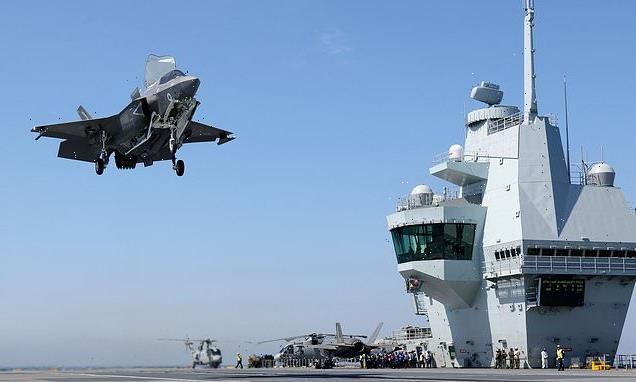Four RAF F-35Bs passed within 600ft of a civilian helicopter over Norfolk, report into high-speed near-miss finds
- A flight of four F-35B aircraft were on a training exercise from RAF Marham
- A report by the UK Airprox Investigation Board investigated a near miss
- One of the jets passed directly overhead a civilian helicopter and within 600ft
- The Airprox board praised the civilian crew for reducing the chance of a crash
Four RAF F-35B fighter jets came within 600ft of a helicopter flying over Norfolk during a training exercise.
The helicopter pilot reported the for RAF jets for flying dangerously, claiming one of the £80m jets passed directly overhead at with just 300ft of separation.
The helicopter’s co-pilot noted his anti collision TCAS system recorded one jet passed within 500ft of a collision.
However, one of the military jets failed to see the helicopter and an investigation report found the F-35s are not fitted with the vital anti-collision system.
Radar returns from the day found the the RAF jets approached from behind the helicopter at more than twice the speed of the civilian aircraft.
A flight of four RAF F-35 B aircraft, similar to this one, were involved in a near-miss involving a civilian Augusta Westland AW-139 helicopter over Norfolk
A report by the UK Airprox Board showed how one of the four F-35 jets passed directly overhead of the helicopter
The Airprox Board launched an investigation after receiving a report from the pilot of the Augusta Westland AW-139 helicopter, who claimed the F-35 pilots’ actions were ‘inappropriate’.
According to the report, the helicopter pilot assessed the risk of collision as ‘high’.
The AW-139 pilot had been warned by Air Traffic Control that the military jets were in the area giving him time to scan the sky to spot three of the four jets. As a result, he descend from 3,000ft to 2,700ft and then to 2,500ft, to reduce the risk of a collision.
He claimed the first jet passed about a mile ahead of him, but the second passed directly overhead.
The pilot was able to track the third jet visually, but did not see the fourth and final jet.
The Airprox Board noticed that Covid-19 restrictions have seen a reduction in the number of controllers available which will now be addressed during busy periods.
During interviews with the military air traffic controllers at RAF Marham, it emerged that they are working with ‘degraded equipment’.
The UK Airprox board received this image from military air traffic controllers from the time of the incident. The board noted the military controllers were operating with ‘degraded equipment’ which are ‘sensitive to interference and clutter’
According to the report: ‘The controller’s honest appraisal highlights the challenges faced by controllers and the propensity for cognitive error when managing complex situations, with sometimes degraded equipment.
‘The Watchman radar is sensitive to interference and clutter, particularly during the kind of weather experienced that week.’
The report noted the F-35 is equipped with ‘many sensors that man pick up potential airborne conflicts’.
However, the fifth-generation fighter jets ‘were able to pick up the AW-139, albeit late’.
The Airprox board has ordered all F-35 pilots to read the contents of their report into the incident ‘as a case study to help improve awareness of the importance of lookout as much as the continued need to follow good airmanship practice’.
The experts concluded: ‘The crew of the AW139 are to be commended for their lookout and proactive actions to help reduce the risk of a collision; without this manoeuvre, the CPA would have been significantly closer.
‘The pilot of [F35 #2] did well to pass on traffic information to the rest of the formation, thus reducing any further risk of conflict.’
Despite the advanced sensors onboard the F-35 B, they are not equipped with the TCAS anti-collision technology.
One military member of the Airprox Board told fellow members: ‘The highly dynamic flight profiles of military fast jets created a multitude of problems with respect to TCAS operation.
‘TCAS maximum closing speeds and rates of climb and descent could easily be exceeded and formation activity invariably created nuisance alarms, adversely affecting pilot sensitivity to the alarms themselves.’
Source: Read Full Article



